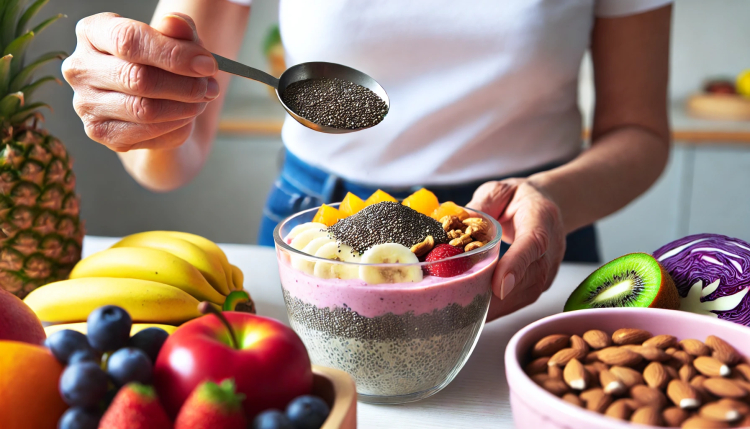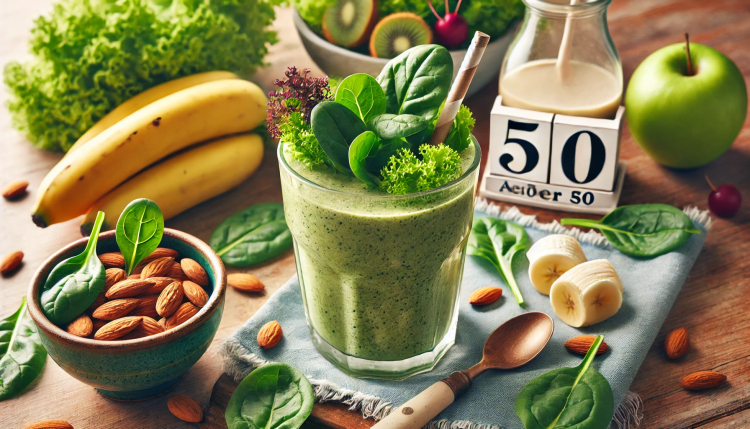Adapting Your Diet to Thrive Over 50: Essential Foods and Nutrients for Healthy Aging

Aging is an incredible journey, and the choices we make along the way can significantly influence our health, energy, and quality of life. For women over 50, adapting your diet to meet changing nutritional needs is essential. This comprehensive guide explores the key foods and nutrients that help you thrive, maintain vitality, and age gracefully.
The Changing Nutritional Needs After 50
After turning 50, your body begins to require fewer calories, but the need for nutrient-dense foods becomes more critical. Hormonal shifts, particularly around menopause, can bring changes that impact metabolism, bone density, and muscle mass. To manage these changes effectively, focusing on quality nutrition is key to promoting a healthy aging process.
A slower metabolism also means that managing body weight can become more challenging. This makes it important to consume foods that provide maximum nutritional value without excessive calories. Prioritizing nutrient-rich foods that support bone health, muscle maintenance, and overall wellness helps you stay active and feel your best.

Key Nutrients for Women Over 50
1. Calcium and Vitamin D for Bone Health
Bone health becomes a significant focus after age 50, especially for women who are more prone to osteoporosis. Calcium and Vitamin D are essential to maintain bone density and prevent fractures. Foods rich in calcium, such as low-fat dairy products, dark leafy greens like kale and collard greens, and fortified plant-based milks, are important dietary staples. Vitamin D, which aids calcium absorption, can be obtained from fatty fish, egg yolks, and regular sun exposure. Many women may also consider a Vitamin D supplement, particularly during winter months.
Weight-bearing exercises such as walking, jogging, or light strength training can also support bone health, complementing your calcium and Vitamin D intake.
2. Protein for Muscle Maintenance
Maintaining muscle mass is crucial as we age, helping support mobility and metabolic health. After 50, the body needs more protein to preserve lean muscle tissue. Include lean protein sources such as chicken, turkey, eggs, and fish. Plant-based proteins like lentils, chickpeas, and quinoa are also great options. Try to spread protein intake evenly throughout the day to optimize muscle repair and growth.
Incorporating protein with every meal not only helps maintain muscle but also keeps you feeling full longer, which can help with weight management. Greek yogurt, cottage cheese, and protein-rich smoothies are excellent choices for snacks or quick meals.

3. Omega-3 Fatty Acids for Heart and Brain Health
Heart health is another priority for women over 50. Omega-3 fatty acids are known to reduce inflammation and support cardiovascular function. Foods like salmon, sardines, flaxseeds, chia seeds, and walnuts are excellent sources. Omega-3s are also linked to improved brain health, helping to maintain cognitive function and reduce the risk of mental decline.
If you don’t eat fish regularly, consider an omega-3 supplement derived from fish oil or algae to ensure you’re getting adequate levels of these essential fats. Omega-3s can also help manage joint pain and stiffness, which becomes more common as we age.
4. Fiber for Digestive Health
Digestive health can become more of a concern as we age. Fiber is essential for maintaining a healthy gut, preventing constipation, and controlling cholesterol levels. Foods such as oats, beans, lentils, fruits, and vegetables are rich in fiber. Aim for a mix of soluble and insoluble fiber to keep your digestive system functioning smoothly.
Soluble fiber, found in foods like oats and apples, helps lower cholesterol and control blood sugar levels. Insoluble fiber, found in whole grains and vegetables, helps maintain regular bowel movements. Both types are important for gut health and overall wellness.

5. Antioxidants for Cellular Health
Antioxidants play a vital role in combating oxidative stress, which can accelerate aging. Foods rich in antioxidants help protect your cells from damage, supporting overall health. Berries, such as blueberries and strawberries, are packed with antioxidants, as are nuts, seeds, and colorful vegetables like bell peppers and carrots. Green tea is another excellent source of antioxidants that can easily be added to your daily routine.
Including a variety of colorful fruits and vegetables in your diet ensures that you get a wide range of antioxidants. Each color represents different beneficial compounds, so aim for a "rainbow" of produce to maximize health benefits.
Building a Balanced Diet to Thrive
1. Prioritize Whole Foods
The foundation of a diet for healthy aging should be built on whole, unprocessed foods. Whole grains like quinoa, brown rice, and oats provide complex carbohydrates that offer sustained energy. Fresh fruits and vegetables should make up a significant portion of your meals, providing essential vitamins, minerals, and antioxidants.
Processed foods often contain added sugars, unhealthy fats, and excess sodium, all of which can contribute to health issues. Choosing whole foods helps you avoid these additives while delivering more nutrients per calorie.
2. Healthy Fats Are Your Friend
Healthy fats are vital for nutrient absorption and hormone balance. Incorporate sources of unsaturated fats, such as avocados, olive oil, and nuts, into your diet. These fats also support heart health, reducing bad cholesterol levels and promoting good cholesterol.
Omega-3 fatty acids, found in fatty fish, flaxseeds, and walnuts, are particularly beneficial. Including these healthy fats in your diet not only supports cardiovascular health but also helps with brain function and reduces inflammation.
3. Stay Hydrated
Hydration is often overlooked but becomes increasingly important as we age. Dehydration can lead to fatigue, confusion, and joint discomfort. Aim to drink at least 8 cups of water a day. Herbal teas and water-rich foods like cucumbers, oranges, and watermelon can also help maintain hydration levels.
As we age, our sense of thirst can diminish, making it crucial to drink water regularly even if you don't feel thirsty. Carrying a water bottle with you and sipping throughout the day can help you stay on track.

4. Balanced Meals and Portion Control
A balanced plate is key—focus on filling half your plate with vegetables, a quarter with lean protein, and a quarter with whole grains. Portion control is particularly important since metabolic rates tend to slow down with age, making it easier to gain weight. Smaller, more frequent meals can help maintain energy levels and prevent overeating.
Including a source of healthy fat and fiber in each meal also helps with satiety, preventing hunger between meals. This approach can make it easier to manage weight without feeling deprived.
Practical Tips for Adapting Your Diet
-
Meal Planning: Planning your meals in advance helps ensure you get the right nutrients daily. Preparing meals with a variety of vegetables, proteins, and whole grains keeps things interesting and balanced. Batch cooking on weekends can make it easier to have healthy meals ready throughout the week.
-
Smart Snacking: Choose nutrient-dense snacks like almonds, Greek yogurt, or apple slices with peanut butter. Avoid processed snacks high in sugar or unhealthy fats, which can lead to energy crashes. Keeping healthy snacks within reach makes it more likely that you'll make good choices.
-
Cooking Methods: Opt for cooking methods that preserve nutrients, such as steaming, baking, or grilling. Avoid deep-frying foods, as it adds unnecessary calories and reduces nutrient value. Cooking at lower temperatures and avoiding charred foods can also minimize the intake of harmful compounds.
-
Limit Sugar and Salt: Reducing added sugars and salt is important for heart health. Instead of sugary drinks, try infusing water with fruits like lemon or berries. Use herbs and spices to flavor food rather than relying on salt. Fresh herbs, garlic, and spices like turmeric and cumin not only add flavor but also provide additional health benefits.

Sample Daily Meal Plan for Women Over 50
-
Breakfast: Overnight oats with chia seeds, almond milk, and mixed berries. This meal is rich in fiber, healthy fats, and antioxidants, setting a positive tone for the day.
-
Morning Snack: Greek yogurt with a handful of walnuts. This snack provides protein and omega-3 fats, helping to keep you full and energized.
-
Lunch: Grilled salmon on a bed of spinach, quinoa, and roasted vegetables, drizzled with olive oil. This meal is rich in omega-3s, fiber, and vitamins, supporting heart and brain health.
-
Afternoon Snack: Sliced bell peppers with hummus. This snack is full of fiber and healthy fats, promoting digestive health and satiety.
-
Dinner: Stir-fried tofu with mixed vegetables (broccoli, bell peppers, carrots) and brown rice. This meal provides a mix of protein, vitamins, and complex carbohydrates to support muscle maintenance and overall energy.
-
Evening Snack: A small piece of dark chocolate and green tea. Dark chocolate is rich in antioxidants, while green tea provides a gentle boost and further antioxidant support.

Conclusion
Adapting your diet after 50 is all about making thoughtful choices that nourish your body and promote long-term health. By focusing on nutrient-dense foods, staying active, and prioritizing hydration, you can maintain your energy levels, support your bones and muscles, and improve overall well-being. Remember, healthy aging is a journey, and every small change you make adds up to a stronger, healthier you.
What's Your Reaction?





















